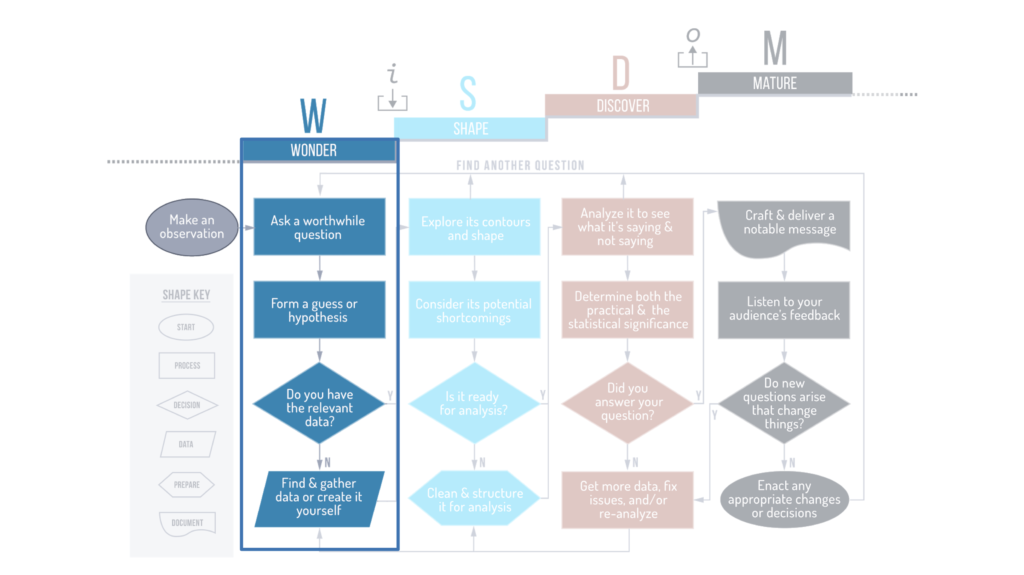1. W: The WONDER Phase
Introduction to Phase 1: The WONDER Phase
Welcome to the first phase of the WISDOM Data-Working Flow! The first phase is called the WONDER Phase. In this phase, you’ll start off on the right foot by thinking clearly about your situation and your data. The steps in this first phase are often glossed over or completely skipped in a rush to just dive into the data. But it’s important to set the stage for success by taking a brief moment to make sure your observations, your questions, and your hypotheses are sound, and that the data you gather is relevant.
Where are You in the Flowchart?

Course Project Next Steps
For the Data Literacy Level 2 Course Project, you will identify a data set that helps you address a question you have about your own world. You’ll bring your own data to the table and apply what you learn throughout the course in real time so that the learnings stick. The goal of the course project is to help you learn how to work effectively with data that matters to YOU.
WONDER Phase Instructions
1.1 Making Keen Observations
Choose a topic of interest in your life for which you want to use data to learn or improve in some way. The topic of interest can come from any of the “3 Domains of Application” covered in the Data Literacy Fundamentals course – namely, professional, personal, or public.
- What are some of your key observations about this topic?
- What’s the source of your observations?
- What do you observe about yourself relative to this topic?
- What are your positive emotions (hopes, aspirations, joys, etc.) about it?
- What are your negative emotions (fears, concerns, woes, etc.) about it?
- What cognitive biases or perceptual limitations might be influencing you?
1.2 Asking Worthwhile Questions
Pose a worthwhile question about your chosen topic of interest:
- Using the “5 W’s and 1 H”
- “A Dozen ‘Hows’ to Ask Your Data”
Next, articulate why this question matters to you:
- So What?
Finally, think about whether there might be some things about the situation that you won’t see in the data. For example, if you’re looking at confirmed cases of a disease, you won’t see cases that weren’t detected or reported.
- What might be missing about the situation?
1.3 Forming a Falsifiable Hypothesis
Think about the question you have posed and form a hypothesis about the answer to that question.
- A basic hypothesis – use this form of hypothesis if your question relates to historical data and you’ll be dealing with all of the data, not just a sample (e.g., “I think I’ll find that Country A increased in life expectancy more than Country B did from year X to year Y“).
- Is this hypothesis falsifiable, or, at least theoretically possible to prove wrong?
- A statistical hypothesis – use this form if you’ll be working with data collected from a random sample taken from a population, and then using that sample data to draw conclusions about a larger population, such as with a survey, poll, or trial of some sort. Don’t forget, you’ll need a null hypothesis and an alternative hypothesis.
1.4 Finding, Gathering, or Creating Data
Look at your observation, question, and hypothesis, and ask yourself if you have data that will help you put this hypothesis to the test and answer your question.
- If so, then congratulations! You can skip to the next step – you’re headed to the SHAPE Phase.
- If not, then you’ll need to get your hands on some good data to proceed.
- Is there a data set that already exists that you can access? Then do so!
- Do you need to select or filter records to just what’s relevant? Then use whatever tool you can use to get data that’s relevant to your inquiry.
- Is it a data set that doesn’t exist that you’ll need to create? Then do so!
- If it’s sample data, then make sure your samples are representative of the population from which they are being drawn. Eliminate any sources of bias and use a sample size that’s as large as is feasible given the time and budget constraints you’re working with. Shoot for a sample size of no less than 30.
- Is there a data set that already exists that you can access? Then do so!